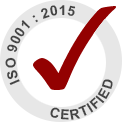Gallium Phosphide Etchant
For Light Emitting Diodes
Controlled chemical etching of gallium phosphide for light emitting diodes, (LED), and matrix arrays with dielectric isolation.
FEATURES
- Produces polished, unpitted surface
- Does not attack silica or titanium masks or beam lead metallizations
- Removes surface damage
- Etches <100> and <111> crystal orientations
- Etch rate 5 mils/hour at 80 °C
GALLIUM PHOSPHIDE ETCHANT DESCRIPTION:
Transene Gallium Phosphide Etchant is an effective etchant designed for the fabrication of light emitting diodes and diode matrix arrays. It offers controlled chemical etching of gallium phosphide to produce mesa structures required for efficient LED and for the separation of LED to generate matrix arrays of alpha numeric displays. During the separation the LED can be shaped into domed structures also essential for efficient electroluminescent devices. The etchant is, furthermore, compatible with lead beam technology.
Transene Gallium Phosphide Etchant exhibits a high etch rate for all crystal orientations. All crystal faces of the <100> orientation of GaP are etched uniformly, producing a polished, unpitted surface. The faces of the <111> orientation etch differently; the <111> (Ga plane A face) develops a smooth orange-peel surface, whereas the <111> (P plane B face) becomes smooth, polished and unpitted. N- and P-type GaP have equivalent etch rates.
GaP Etchant is a stable, consistent formulation based on potassium hexacyanoferrate and easily applied to the manufacture of state-of-the-art gallium phosphide LED and beam lead electroluminescent devices. The etchant does not attack Pd, Au or Pt lead beam metallizations. Ti and SiO2 masks show minimal attack. GaP Etch is also effective for gallium nitride etching applications.
PROPERTIES OF TRANSENE GALLIUM PHOSPHIDE ETCHANT
| How do I increase the etch rate? | 1. The rate will approximately double with every 10°C increase in temperature. 2. Increase the rate of stirring or agitation. |
||||||||||||
| How do I reduce the etch rate? | Adding 1 part deionized water to 2 parts etchant will reduce the etch rate approximately 50%. | ||||||||||||
| Do I need to dilute the etchant? | No, it is ready to use. | ||||||||||||
| How do I reduce undercutting? | Increase the rate of stirring or agitation. | ||||||||||||
| Appearance | Amber-brown | ||||||||||||
| pH | 13-14 | ||||||||||||
|
|||||||||||||
| Etch Capacity (rate declines at ~70%) | 12 g/L | ||||||||||||
| Shelf Life | 1 year | ||||||||||||
| Storage Conditions | Ambient | ||||||||||||
| Filtration | 1 um | ||||||||||||
| Recommended Operating Temperatures | 70-80 oC | ||||||||||||
| Rinse | Deionized water | ||||||||||||
| Photoresist Recommendations | PKP-308PI or HARE SQ (SU-8 type) | ||||||||||||
| Select Compatible Materials | Glass, Au, Ni
See https://transene.com/etch-compatibility/ for more details. |
||||||||||||
| Select Incompatible Materials | Al, Cr, Mo, W | ||||||||||||
| Compatible Plastics | HDPE, PP, Teflon, PFA, PVC | ||||||||||||
| Country of Origin | USA | ||||||||||||
| Availability | 1-2 days | ||||||||||||
| Available Sizes | Quart, Gallon, 5 Gallon, 55 Gallon | ||||||||||||
| Packaging | HDPE | ||||||||||||
| Packing | 4 gallons/case | ||||||||||||
| Isotropy | Isotropic | ||||||||||||
| Incompatible Chemicals | Strong acids | ||||||||||||
| Additional Information | Non-toxic |
APPLICATION:
Transene Gallium Phosphide Etchant is employed in several manufacturing operations for the production of light emitting diodes. The etchant may be used first to remove surface damage of mechanically polished p-type and n-type gallium phosphide. The following procedures are generally followed for device fabrication:
- Formation of mesa configuration with GaP etchant and SiO2 as a mask.
- Beam lead metallization and contact metallizations using photoresist techniques.
- Separation of GaP wafer into individual dies, by partial cutting with abrasive dicing machines followed by chemical etching with Transene GaP Etchant.

